Are you looking to bring a touch of tropical elegance to your home decor? If so, indoor palms may be the perfect solution for you. These lush and vibrant plants not only add a sense of natural beauty but also create a peaceful and relaxing ambiance. But with so many options available, how do you choose the right indoor palm for your home?
In this article, I will guide you through the world of indoor palms and introduce you to 8 great palms that are guaranteed to enhance your home. From the popular Areca Palm to the elegant Kentia Palm, each palm has its unique characteristics and care requirements. So, let’s dive in and discover the perfect indoor palm that will transform your living space.
Introduction
In this introduction, let me give you a brief overview of indoor palms and explain why they make great additions to home decor. Indoor palms are not only aesthetically appealing, but they also bring a host of benefits to indoor spaces. These plants have the power to transform any room into a lush and tropical oasis. And the best part? They are surprisingly easy to care for, even for those without a green thumb. Let’s explore the world of indoor palms and discover the joys they can bring to your home.
Indoor Palms: 8 Great Palms That Enhance Your Home
In this section, I will introduce 8 great palms that are perfect for indoor gardening. These palms are not only beautiful but also bring a touch of tropical paradise into your home. Let’s explore each palm and discover their unique characteristics and visual appeal.
1. Areca Palm: The Areca Palm, also known as Dypsis lutescens, features feathery, arching fronds that add a touch of elegance to any space. This palm can reach a height of 6 to 8 feet indoors and thrives in bright, indirect sunlight. Regular watering and occasional misting to increase humidity are essential for its care.
2. Parlor Palm: If you’re looking for a small palm that requires minimal maintenance, the Parlor Palm (Chamaedorea elegans) is the perfect choice. It can grow up to 4 feet tall and is highly adaptable to low light conditions. Regular watering, well-drained soil, and moderate humidity are key to its thriving.
3. Kentia Palm: The Kentia Palm (Howea forsteriana) is renowned for its elegant, arching fronds and ability to tolerate low light conditions. This palm can grow up to 10 feet tall indoors and requires well-drained soil, moderate humidity, and regular watering to flourish.
4. Lady Palm: The Lady Palm (Rhapis excelsa) is an elegant palm with fan-shaped leaves that bring a touch of sophistication to any home. It is a slow-growing palm that can reach a maximum height of 5 to 7 feet indoors. Bright, indirect light and well-drained soil are essential for its optimal growth.
5. Majesty Palm: Majestic in both name and appearance, the Majesty Palm (Ravenea rivularis) features arching fronds and a slightly swollen trunk base. This palm grows up to 10 feet indoors and thrives in bright, indirect light. Well-drained soil, regular watering, and moderate humidity are necessary for its health.
6. Bamboo Palm: The Bamboo Palm (Chamaedorea seifrizii) is a versatile palm that can adapt to a wide range of lighting conditions. It has slender, bamboo-like stems and feathery fronds that bring a sense of tranquility to any space. Regular watering, well-drained soil, and moderate humidity are key to its thriving.
7. Ponytail Palm: The Ponytail Palm (Beaucarnea recurvata) is a unique palm that stores water in its swollen trunk base, resembling a ponytail. It can reach a height of 6 feet indoors and thrives in bright, indirect light. Well-drained soil and occasional watering are important for its care.
8. Cat Palm: The Cat Palm (Chamaedorea cataractarum) is a dense, clumping palm that adds a touch of lushness to any indoor space. With its dark green fronds and short trunk, it can grow up to 6 feet tall. Bright, indirect light and consistently moist soil are key to its growth.
To get a better visual understanding of these 8 great indoor palms, take a look at the image below:
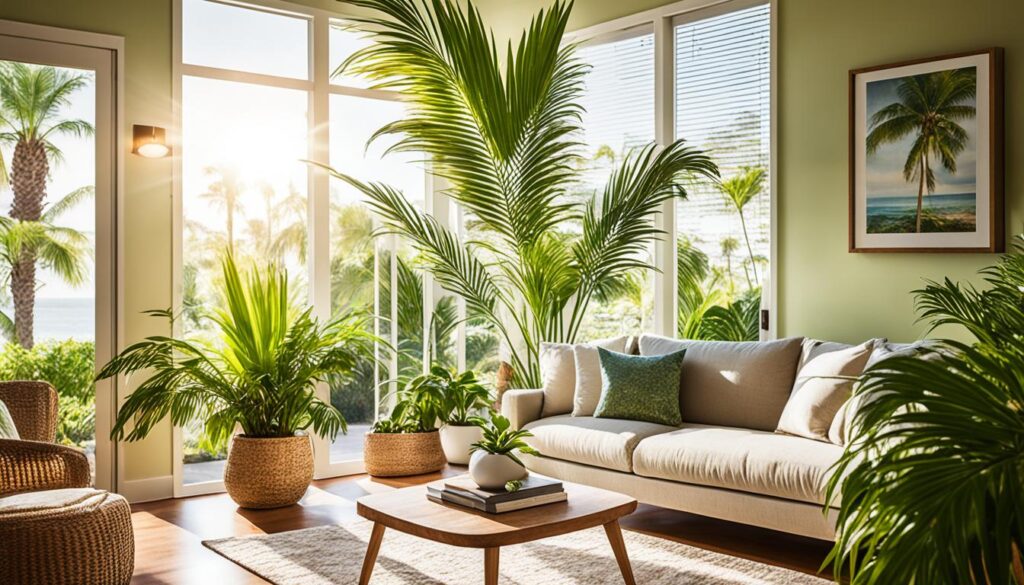
Now that we’ve explored these 8 great palms, it’s time to move on to choosing the right palm for your home. Let’s proceed to the next section.
3. Choosing the Right Palm for Your Home
Choosing the right palm for your home is essential for the health and longevity of your indoor garden. There are several factors to consider when selecting a palm, including lighting conditions, room size, personal preferences, and the growth habit and size of the palm itself.
To ensure optimal growth, it is important to assess the lighting conditions in your home. Some palms thrive in bright, indirect sunlight, while others are more tolerant of low light conditions. Consider the natural lighting in the room where you plan to place the palm and choose a palm variety that suits those conditions.
Another factor to consider is the size and growth habit of the palm. Some palms can grow quite tall, reaching heights of up to 10 feet, while others are more compact and better suited for smaller spaces. Take measurements of the area where you want to place the palm and consider both the height and width of the mature palm to ensure it fits well within your space.
Personal preferences also play a role in choosing the right palm. Consider the overall aesthetic you want to create in your home and choose a palm that complements that style. Whether you prefer the tropical and feathery fronds of an Areca Palm or the elegant and slender leaves of a Kentia Palm, there is a palm variety to suit every taste.
By considering these factors and taking the time to choose the right palm for your home, you can create a beautiful and thriving indoor garden that enhances the ambiance of your living space.
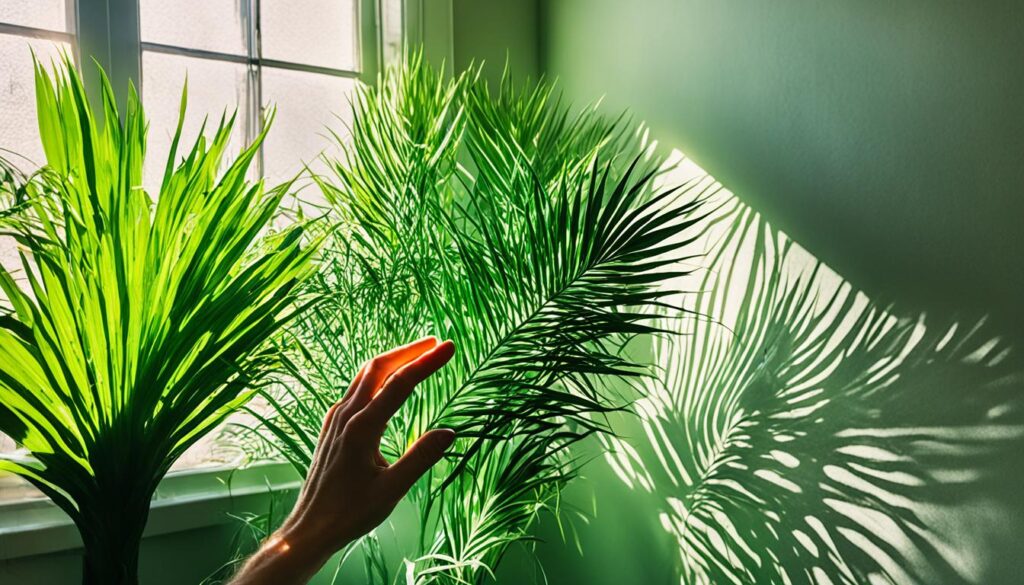
4. 8 Great Palms for Indoor Gardening
In this section, I will delve deeper into each of the 8 great palms mentioned earlier. For each palm, I will provide detailed information on its care requirements, including lighting, watering, temperature, and humidity preferences. I will also discuss any specific considerations or challenges that may arise when caring for each palm.
Areca Palm (Dypsis lutescens)
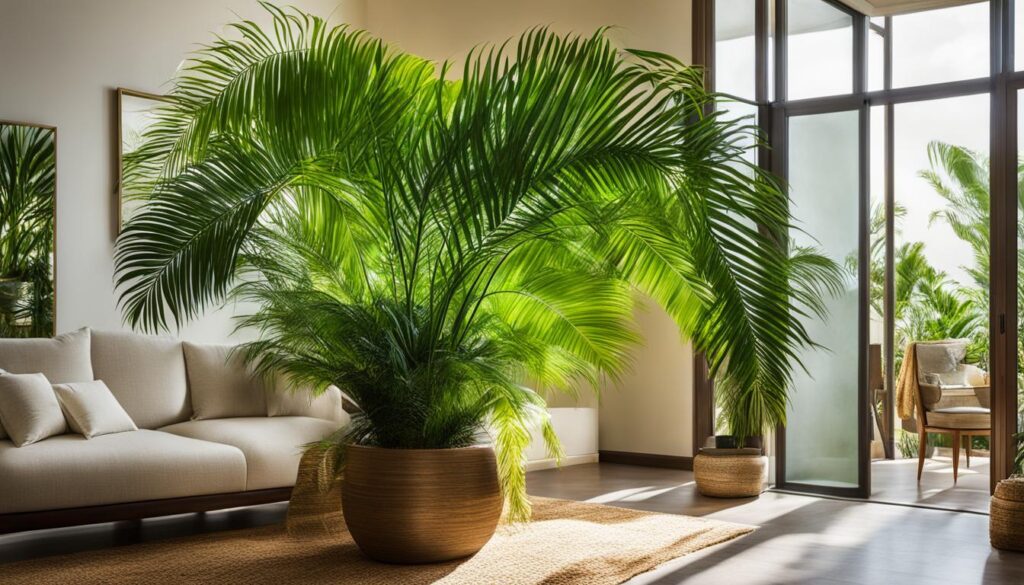
The Areca Palm, also known as Dypsis lutescens, is a popular choice for indoor gardening. It features feathery, arching fronds and can reach a height of 6 to 8 feet indoors. It prefers bright, indirect sunlight and well-drained soil. Regular watering and occasional misting to increase humidity are essential for its care.
Parlor Palm (Chamaedorea elegans)
The Parlor Palm, scientifically known as Chamaedorea elegans, is a small palm that can grow up to 4 feet tall. It is highly adaptable and can tolerate low light conditions, making it an excellent choice for indoor environments. It prefers well-drained soil, moderate humidity, and regular watering.
Kentia Palm (Howea forsteriana)
The Kentia Palm, also called Howea forsteriana, is a beautiful palm that can grow up to 10 feet tall indoors. It has elegant, arching fronds and is known for its tolerance to low light conditions. It requires well-drained soil, moderate humidity, and regular watering to thrive.
Lady Palm (Rhapis excelsa)
The Lady Palm, or Rhapis excelsa, is an elegant palm with fan-shaped leaves. It is a slow-growing palm that can reach a maximum height of 5 to 7 feet indoors. It prefers bright, indirect light and well-drained soil. Keeping moderate humidity and watering regularly are important for its care.
Majesty Palm (Ravenea rivularis)
The Majesty Palm, scientifically known as Ravenea rivularis, is a tall and graceful palm that can grow up to 10 feet indoors. It features arching fronds and a slightly swollen trunk base. It thrives in bright, indirect light and requires well-drained soil. Regular watering and maintaining moderate humidity are necessary for its health.
Bamboo Palm (Chamaedorea seifrizii)
The Bamboo Palm, also referred to as Chamaedorea seifrizii, is a versatile palm that can adapt to a wide range of lighting conditions. It has slender, bamboo-like stems and feathery fronds. It can grow up to 8 feet tall and prefers well-drained soil and moderate humidity. Regular watering is crucial for its care.
Ponytail Palm (Beaucarnea recurvata)
The Ponytail Palm, scientifically known as Beaucarnea recurvata, is a unique palm that stores water in its swollen trunk base. It has long, slender leaves that cascade like a ponytail, hence the name. It can reach a height of 6 feet indoors and prefers bright, indirect light and well-drained soil. It is drought-tolerant and requires infrequent watering.
Cat Palm (Chamaedorea cataractarum)
The Cat Palm, or Chamaedorea cataractarum, is a dense, clumping palm that can grow up to 6 feet indoors. It features dark green fronds and a short trunk. It prefers bright, indirect light and consistently moist soil. Maintaining moderate to high humidity is important for its growth.
| Palm | Scientific Name | Height (Indoors) | Lighting | Watering | Soil |
|---|---|---|---|---|---|
| Areca Palm | Dypsis lutescens | 6-8 feet | Bright, indirect sunlight | Regular watering, occasional misting | Well-drained soil |
| Parlor Palm | Chamaedorea elegans | Up to 4 feet | Low light tolerant | Regular watering | Well-drained soil |
| Kentia Palm | Howea forsteriana | Up to 10 feet | Low light tolerant | Regular watering | Well-drained soil |
| Lady Palm | Rhapis excelsa | 5-7 feet | Bright, indirect light | Regular watering | Well-drained soil |
| Majesty Palm | Ravenea rivularis | Up to 10 feet | Bright, indirect light | Regular watering | Well-drained soil |
| Bamboo Palm | Chamaedorea seifrizii | Up to 8 feet | Adaptable | Regular watering | Well-drained soil |
| Ponytail Palm | Beaucarnea recurvata | 6 feet | Bright, indirect light | Infrequent watering | Well-drained soil |
| Cat Palm | Chamaedorea cataractarum | Up to 6 feet | Bright, indirect light | Consistently moist soil | Well-drained soil |
5. Caring for Your Indoor Palms
Proper care is crucial for the health and growth of indoor palms. To ensure your indoor palms thrive, it’s important to provide them with the right conditions and care. Here are some comprehensive care tips for your indoor palms:
- Lighting: Most indoor palms prefer bright, indirect light. Place your palms near a window that receives filtered sunlight. Avoid exposing them to direct sunlight as it can scorch their leaves.
- Watering: Palms generally prefer to be kept evenly moist but not overly saturated. Check the top inch of soil, and water when it feels slightly dry. Ensure proper drainage by using a well-draining potting mix and pots with drainage holes.
- Humidity: Indoor palms thrive in humid environments. Increase humidity by misting the foliage regularly or placing a tray of water near the plants. You can also use a humidifier to maintain optimal humidity levels.
- Temperature: Most indoor palms prefer temperatures between 65-85°F (18-29°C). Avoid exposing them to drastic temperature fluctuations, drafts, or cold air from air conditioning units.
- Fertilization: Feed your indoor palms with a balanced, water-soluble fertilizer once a month during the growing season (spring and summer). Follow the instructions on the fertilizer package for proper dilution and application.
In addition to providing optimal care, it’s essential to be aware of common problems and pests that can affect indoor palms. Here are some common issues and how to remedy them:
- Yellowing leaves: Yellow leaves can indicate overwatering, underwatering, or nutrient deficiencies. Adjust your watering schedule, ensure proper drainage, and consider fertilizing if nutrient deficiencies are suspected.
- Brown tips: Brown tips usually indicate dry air or inadequate humidity levels. Increase humidity by misting or using a humidifier, and avoid placing palms near heating vents.
- Spider mites: These tiny pests can infest indoor palms and cause yellowing leaves with webbing. Use an insecticidal soap or neem oil spray to treat spider mites. Repeat the treatment as necessary.
- Mealybugs: Mealybugs appear as white, cotton-like clusters on the leaves and stems. Remove them manually with a cotton swab dipped in rubbing alcohol or use an insecticidal soap. Repeat the treatment until the infestation is eliminated.
By following these care tips and being attentive to your indoor palms’ needs, you can ensure their health and create a lush, tropical atmosphere in your home.
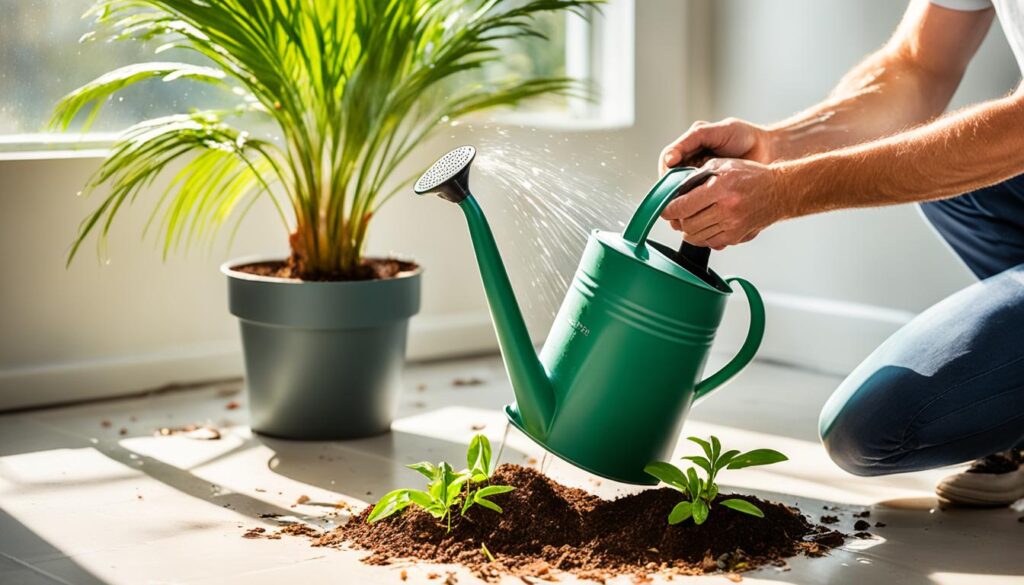
6. Decorating with Palms: Tips and Tricks
Indoor palms are not just beautiful plants; they also have the power to transform the ambiance of your home. With their lush green foliage and tropical vibes, they can create a serene and inviting atmosphere. If you’re wondering how to decorate with palms and make the most of their beauty, here are some tips and tricks to consider:
1. Placement: Place your indoor palms in areas where they can be the focal point of the room. A corner with natural light or near a large window can be the perfect spot to showcase their elegance. Consider creating a grouping of palms to create an even more impactful display.
2. Container options: Choose containers that complement your home decor style while providing proper drainage for the palms. You can opt for sleek and modern pots for a contemporary look, or woven baskets for a more bohemian touch. Remember to choose containers that are the right size to allow for growth and stability.
3. Complementary decor elements: Enhance the tropical feel of your indoor palms by incorporating other elements that complement their beauty. Add decorative rocks or pebbles around the base of the plant for an organic touch. Hang macrame plant hangers nearby for a boho-chic vibe, or place a stylish watering can nearby to add a functional and aesthetic element.
By following these tips and tricks, you can create a stunning decor theme with indoor palms that brings a touch of nature into your home. Whether you prefer a minimalist, modern look or a cozy, eclectic style, indoor palms can seamlessly fit into any design scheme and add a soothing green touch to your living space.
FAQ
Why are indoor palms a popular choice for home decor?
Indoor palms are popular because of their lush green leaves and tropical vibes, which create a sense of peace and relaxation. They enhance the aesthetic appeal of indoor spaces and bring a touch of nature indoors.
What are the benefits of indoor palm plants?
Indoor palm plants not only enhance the beauty of a home but also contribute to the overall ambiance. They improve indoor air quality by releasing oxygen and humidifying the air. Additionally, they can reduce stress and create a calming atmosphere.
Are indoor palms easy to care for?
Yes, indoor palms are generally easy to care for. They have relatively low maintenance requirements and can adapt well to indoor environments. However, it is important to provide them with appropriate lighting, water, and humidity to ensure their health and longevity.
How do I choose the right palm for my home?
When choosing an indoor palm, consider factors such as lighting conditions, room size, and personal preferences. Select a palm that suits the available light in your home and fits well within your space. Also, consider the growth habit and size of the palm to ensure it can thrive in your home environment.
How do I care for indoor palms?
To care for indoor palms, provide them with bright, indirect sunlight, well-drained soil, and regular watering. Maintain moderate humidity levels and avoid exposing them to extreme temperatures. It is also important to periodically dust the palm leaves and monitor for any signs of pests or diseases.
How do I decorate with indoor palms?
To decorate with indoor palms, consider placing them in rooms that need a touch of greenery, such as living rooms, bedrooms, or offices. Use attractive containers that suit your home decor style. You can also incorporate other tropical-themed elements like rattan furniture or vibrant textiles to create a cohesive and inviting atmosphere.


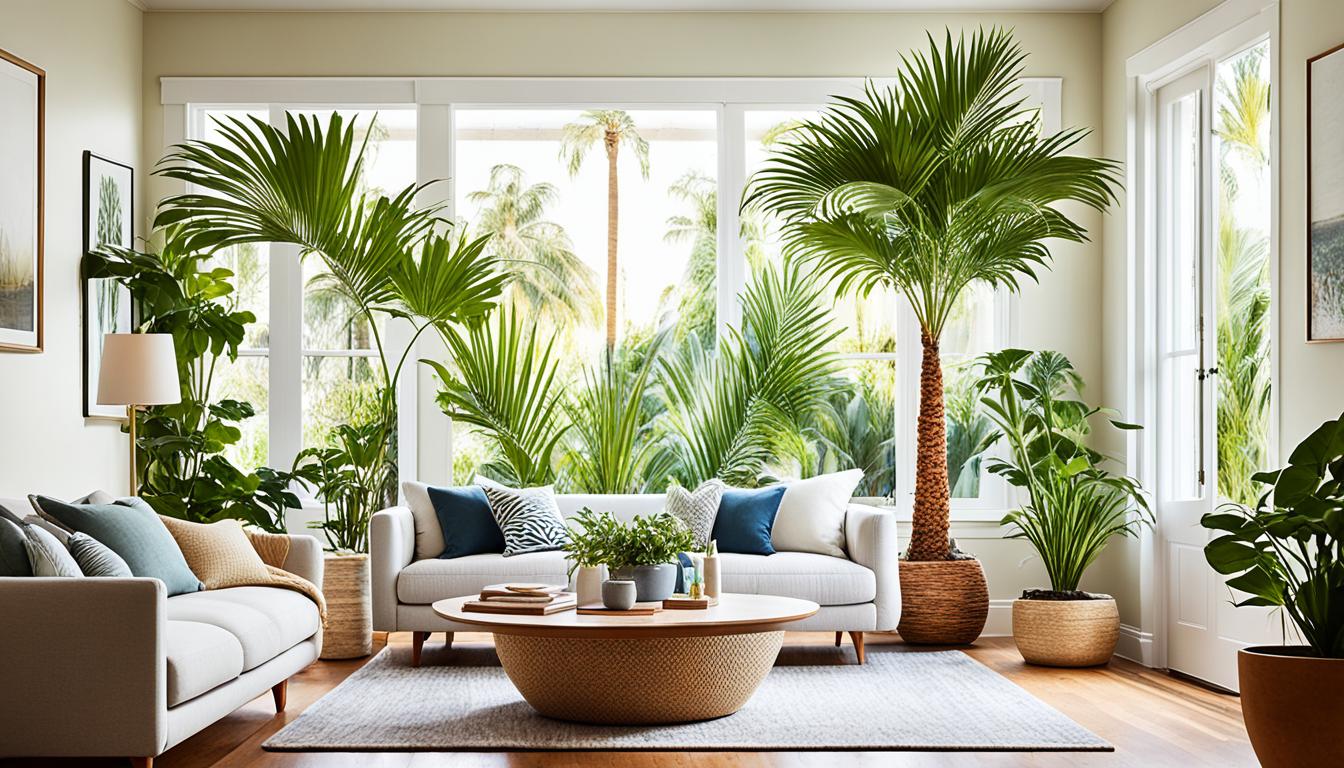

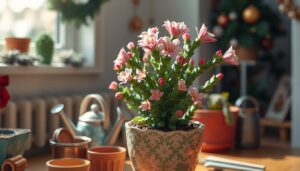
Pingback: Indoor Care Tips for Palm Plants: Nurturing Greenery in Your Home – Trusted House Plant Guide